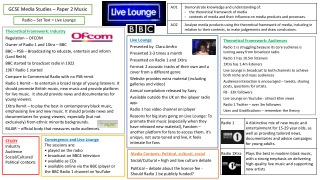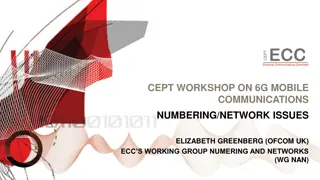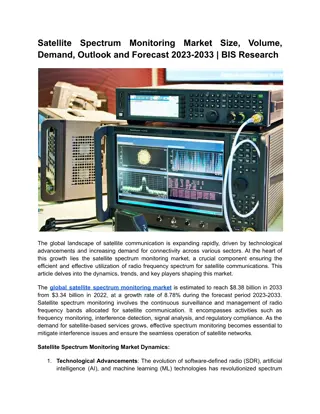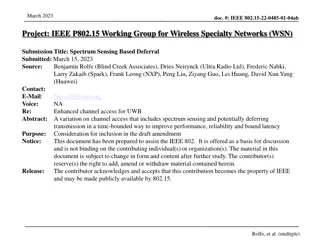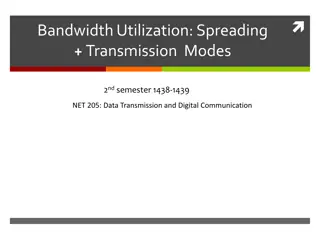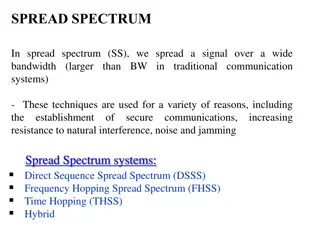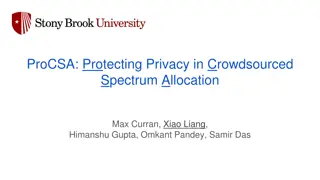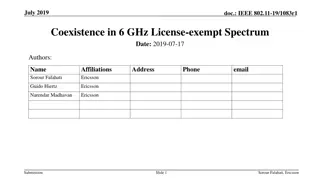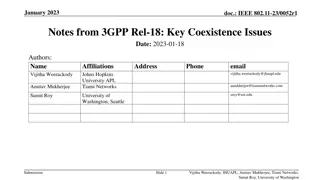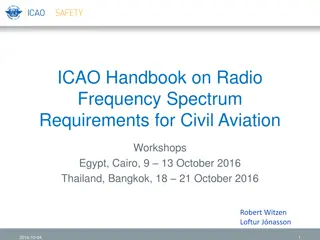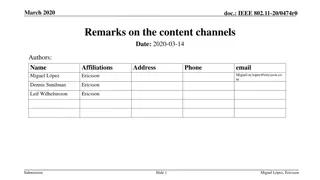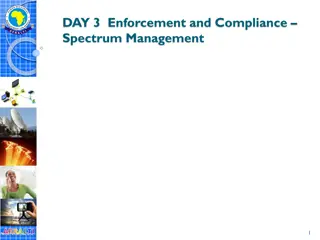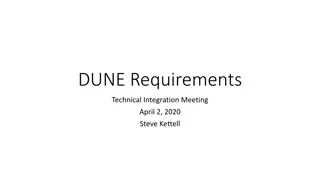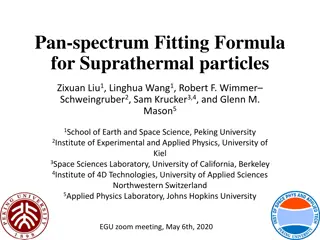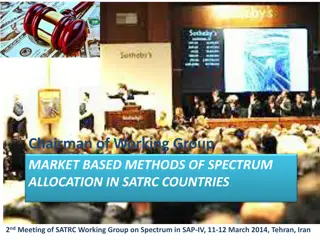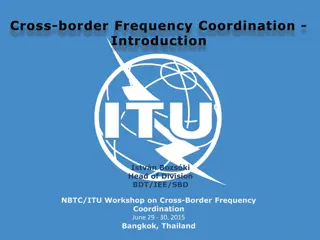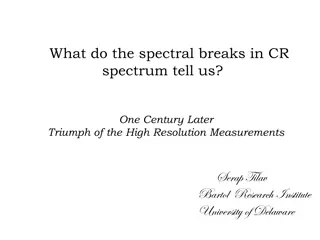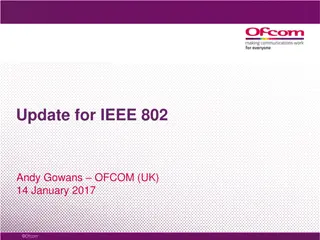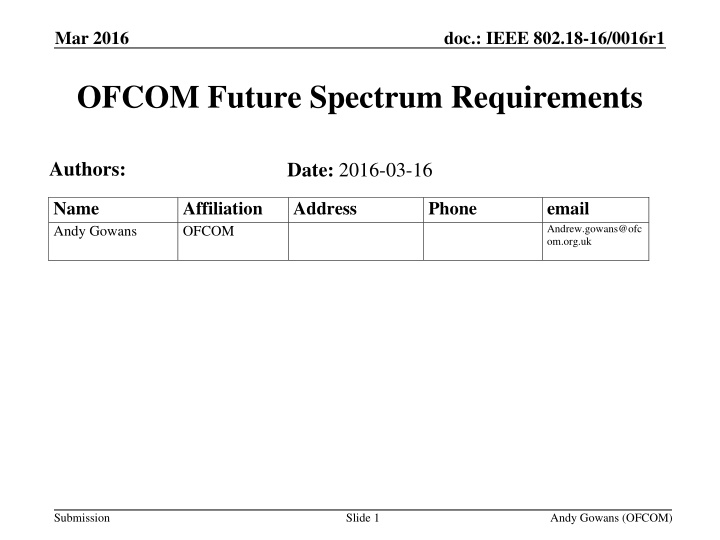
Future Spectrum Requirements for Mobile Data and 5G
The document "Mar.2016.doc" discusses future spectrum requirements for mobile data, 5G, and WRC-15/19, exploring where IEEE 802 fits in. Andy Gowans from OFCOM presents insights on emerging services, spectrum trends, technologies like LTE and Wi-Fi, and the challenges in meeting mobile data demands in the next 10 years. The emphasis is on not letting spectrum limitations hinder the rapid deployment of new services through proactive monitoring, adaptation, international harmonization, and resolution of coexistence issues.
Download Presentation

Please find below an Image/Link to download the presentation.
The content on the website is provided AS IS for your information and personal use only. It may not be sold, licensed, or shared on other websites without obtaining consent from the author. If you encounter any issues during the download, it is possible that the publisher has removed the file from their server.
You are allowed to download the files provided on this website for personal or commercial use, subject to the condition that they are used lawfully. All files are the property of their respective owners.
The content on the website is provided AS IS for your information and personal use only. It may not be sold, licensed, or shared on other websites without obtaining consent from the author.
E N D
Presentation Transcript
Mar 2016 doc.: IEEE 802.18-16/0016r1 OFCOM Future Spectrum Requirements Authors: Date: 2016-03-16 Name Andy Gowans Affiliation OFCOM Address Phone email Andrew.gowans@ofc om.org.uk Submission Slide 1 Andy Gowans (OFCOM)
Mar 2016 doc.: IEEE 802.18-16/0016r1 Future spectrum requirements for mobile data, 5G and WRC-15/19: Where does IEEE 802 fit in? Presenter Andy Gowans input by F. Boccardi, M Paynter, S. Jones, S. Green Submission Slide 2 Andy Gowans (OFCOM)
CONTENT Mar 2016 doc.: IEEE 802.18-16/0016r1 Content Index 1. Future Mobile Data Use 2. Spectrum trends below 6GHz 3. Future studies in 5GHz 4. IEEE 802, 5G and above 6GHz use 5. Summary of Conclusions and points for future discussion Submission 3 Andy Gowans (OFCOM)
(1) Future Mobile Data Use Mar 2016 doc.: IEEE 802.18-16/0016r1 Emerging services Broadband++ high throughput, consistent QoE http://i.kinja-img.com/gawker-media/image/upload/s--CJDk3O5u--/18kzsnnc1v225jpg.jpg http://www.gannett-cdn.com/-mm-/f273eb6f71ec4308c31231919173d9506ae054c0/c=193-0-810-464r=x383c=540x380/local/-/media/USATODAY/test/2013/12/01/1385949215000-AmazonPrimeAir.JPG http://www.nicolas-denis.net/wp-content/uploads/2014/12/baxter-robot-rethink.jpg http://www.ima.umn.edu/2008-2009/PUB1.22.09/Network_Image_Robert_Ghrist_PL_Card.jpg M2M Critical communications low latency, high reliability low cost, low battery consumption SPG Source: modified from ITU Technology Andy Gowans (OFCOM) Submission 4
(1) Future Mobile Data Use Mar 2016 doc.: IEEE 802.18-16/0016r1 Technology trends Broadband++ high throughput, consistent QoE 5G /802.11ax /LAA/LTE-U?? LTE /802.11ac satellites GSM/ LTE Cat 0/ GERAN/ 5G/ Wi-Fi/Sigfox/ [ ] Bluetooth/ ZigBee/ 5G 802.11p LTE D2D / LTE-V Critical communications low latency, high reliability M2M low cost, low battery consumption SPG Technology Andy Gowans (OFCOM) Submission 5
(1) Future Mobile Data Use Mar 2016 doc.: IEEE 802.18-16/0016r1 Lack of spectrum should not inhibit the rapid rollout of new services The approach . The approach . The challenge: what will be the The challenge: what will be the spectrum needs for mobile data in spectrum needs for mobile data in 10 years time? 10 years time? Identify and prioritise potentially suitable bands Monitor demand. market and technology developments, being ready to adapt our approach Take a leading role in international harmonisation discussions Take action resolving coexistence issues, awarding bands Submission 6 Andy Gowans (OFCOM)
CONTENT Mar 2016 doc.: IEEE 802.18-16/0016r1 Executive abstract 1. Future Mobile Data Use 2. Spectrum trends below 6GHz Licenced vs Unlicenced LAA/LTE-U vs WiFi Current and future Wi-Fi use 3. Future studies in 5GHz 4. IEEE 802, 5G and above 6GHz use 5. Conclusions and points for discussion Submission 7 Andy Gowans (OFCOM)
(2) Spectrum trends below 6GHz Mar 2016 doc.: IEEE 802.18-16/0016r1 Licenced spectrum availability in UK/Europe 1800 900 2100 2.6GHz 800 >3.6GHz (harmonised) 1.4GHz 2.3GHz 3.4GHz 700 Total downlink (scenarios) Today Existing mobile bands 2016 Addition of 1452-1492 MHz, 2.3 GHz, 3.4 GHz 2017-2022 Addition of 700 MHz, potentially 1427-1452 MHz, 3.6-3.8 GHz , 1492-1518 MHz >2022 More uncertain potential addition of 3.8-4.2 GHz possibly tiered access ???? Submission 8 Andy Gowans (OFCOM)
(2) Spectrum trends below 6GHz Mar 2016 doc.: IEEE 802.18-16/0016r1 LE (802.11/15/16) spectrum available in UK Frequency Bandwidth UK status Indoor/Outdoor Technical characteristics and capabilities 2.4 2.4835 GHz 83.5 MHz Licence Exempt Indoor and outdoor 100mW EIRP limit 5.15-5.35 GHz 200 MHz Licence Exempt Indoor 200mW EIRP limit DFS and TPC required in the upper half 5.470 5.725 GHz 255 MHz Licence Exempt Indoor/Outdoor 1W EIRP limit DFS and TPC required 5.825 5.875 GHz * 150 MHz Licence Exempt Indoor/Outdoor 25mW EIRP limit No DFS or TPC required 5.725 5850 GHz + 105 MHz Light licensed FWA use only Outdoor 4W EIRP limit DFS and TPC required * Note: This is a generic SRD regulation not RLAN + Note: Not to use 20MHz between 5795 5815 MHz Submission 9 Andy Gowans (OFCOM)
(2) Spectrum trends below 6GHz Mar 2016 doc.: IEEE 802.18-16/0016r1 In 2014 Wi-Fi traffic was 16 times cellular one UK Data carried in PB per month 538.5 MHz available 1600 538.5 MHz available 1200 Wi-Fi 800 1440 PB Cellular 1209 PB 400 602 MHz available 602 MHz available 74 PB 44PB 0 Cisco VNI, 2014 average Infrastructure Report, June 2014 Submission 10 Andy Gowans (OFCOM)
(2) Spectrum trends below 6GHz Mar 2016 doc.: IEEE 802.18-16/0016r1 Wi-Fi vs cellular spectrum trends One assumption that could be taken from this if we thought there was a need to keep the same proportion between licence and license-exempt spectrum in the future we should be adding approx. 600 MHz below 6GHz spectrum for Wi-Fi 2000 Cellular spectrum (MHz) 1800 Wi-Fi spectrum (MHz) 1600 1400 1200 1000 800 600 Currently there is no evidence to back this assumption up or to quantify what the balance will be in the future. Do Wi-Fi alliance have similar info for other countries and do they think future studies are needed here! 400 2015 2020 2025 2030 Note: we don t consider > 6 GHz spectrum Submission 11 Andy Gowans (OFCOM)
Mar 2016 doc.: IEEE 802.18-16/0016r1 Wi-Fi demand trends (2) Current Mobile Data Use in UK and possible spectrum trends. In previous studies and consultation in 2013/14 we looked at future wireless data uses including Wi-Fi. Responses indicated more contiguous channels with wide bandwidths (80 MHz and 160 MHz) mainly for indoor services need for more spectrum for lower bandwidth outdoor deployments with additional steps such as standardised protocols for coordination and restriction on use are needed As a follow on we carried out a demand/supply study to assess the needs of further spectrum for Wi-Fi Varying results depending on assumptions used for demand and supply. Some scenarios showed a need of additional spectrum for all assumptions: Transport hubs Public event-type scenarios (e.g. stadium) To a lesser extent, terrace houses We concluded that more work needs to be done on Wi-Fi spectrum requirements! What about the other IEEE 802 standards and technologies spectrum requirements? Submission 12 Andy Gowans (OFCOM)
(2) Spectrum trends below 6GHz Mar 2016 doc.: IEEE 802.18-16/0016r1 Wi-Fi/LAA/LTE(U) technology trends Wi-Fi as standalone technology More effective MAC solutions (802.11ax) will allow a better performance in high-traffic conditions Wi-Fi features (e.g. Passpoint for cellular like experience, VoWiFi, etc.) Wi-Fi Direct (screen mirroring etc.) Low power/low data rate Wi-Fi for M2M and IoT (below 1GHz?) Wi-Fi LAA/LTE(U) as complementary technology Distributed SON algorithms will allow non-managed Wi-Fi deployments to have performance closer to managed ones Wi-Fi vs LAA will it increase traffic at 5GHz will it enable new opportunities for broadband Wi-Fi operators E.g.: mobility and wide-area support 3G/4G/5G Interworking features? Yes for LAA, What about W-Fi? What are the implications of all these changes on future Wi-Fi spectrum needs? Submission 13 Andy Gowans (OFCOM)
(2) Spectrum trends below 6GHz Mar 2016 doc.: IEEE 802.18-16/0016r1 Some views on LAA/LTE-U vs Wi-Fi Ofcom initial views: Competition is a positive thing for consumers and LAA/LTE(U) could be good for the market. However, it is not clear what kind of effect the introduction of LAA/LTE(U) will have on current Wi-Fi users, that is why, in order to protect consumers, we support the work to develop fair and equitable sharing rules. In Europe the ETSI HS standard is right place to do this work and we are participating in ETSI BRAN. There needs to be studies to asses the impact of LAA/LTE-U use on future spectrum requirements and sharing with other services in 5GHz extension bands. Submission 14 Andy Gowans (OFCOM)
(2) Current Mobile Data Use in UK and possible spectrum trends. Mar 2016 doc.: IEEE 802.18-16/0016r1 BIG ? What are the IEEE802 industry s future spectrum needs? Submission 15 Andy Gowans (OFCOM)
CONTENT Mar 2016 doc.: IEEE 802.18-16/0016r1 Executive abstract 1. Future Mobile Data Use 2. Spectrum trends below 6GHz 3. Future studies in 5GHz UK/Europe vs US allocations in 5GHz Studies from WRC-15 & EU mandate process WRC-19 proposals and studies 4. IEEE802, 5G and above 6GHz use 5. Conclusions and points for discussion Submission 16 Andy Gowans (OFCOM)
(3) Future studies in 5GHz Mar 2016 doc.: IEEE 802.18-16/0016r1 Previous Studies Under WRC-15 AG 1.1 and EU Mandate candidate bands studied: 5350 5470 MHz Current 5GHz RLAN mitigations do not make sharing feasible Studies on additional mitigation techniques not agreed 5725 5850 MHz No conclusions to studies Some studies looking at enhanced DFS to protect Frequency Hopping radar. RLAN use already in each of the ITU-R Regions, regulations vary. 5850 5925 MHz Already a primary mobile allocation in the band No studies carried out as part of WRC-15 period Possible IMT allocation 5925 6425 MHz indicated that low power indoor use by IMT may be feasible (indoor 10mW?) Submission 17 Andy Gowans (OFCOM)
(3) Future studies in 5GHz Mar 2016 doc.: IEEE 802.18-16/0016r1 Summary current UK/EU/CEPT vs. USA Regs. Power Indoor / Outdoor Fixed / Mobile DFS / TPC EU/CEPT Regs UK USA UK USA UK USA UK USA EU CEPT Low High Indoor Indoor & outdoor Fixed & mobile Fixed & mobile No No Yes Yes 5150 to 5250 Low Medium Indoor Indoor & outdoor Fixed & mobile Fixed & mobile Yes Yes Yes Yes 5250 to 5350 Medium Medium Indoor & outdoor Indoor & outdoor Fixed & mobile Fixed & mobile Yes* Yes Yes 5470 Yes to 5725 High High Indoor & outdoor Indoor & outdoor Fixed only Fixed & mobile Yes No No Yes 5725 (BFWA) to 5850 * With longer initial start up time when co-channel with 5.6 to 5.65 GHz weather radars 5.6 to 5.65 GHz to be avoided whilst FCC is trying to introduce rules banning firmware mods Submission 18 Andy Gowans (OFCOM)
(3) Future studies in 5GHz Mar 2016 doc.: IEEE 802.18-16/0016r1 WRC-19 proposals for Future Agenda item on RLANs CITEL proposal Looking for RLAN studies and possible allocation in the 5350-5470 MHz band only UK backed European MCP to study and assess the 5 GHz WAS (incl. RLAN) operational and spectrum requirements over the whole range 5 150-5 925 MHz to study the band 5 350-5 470 MHz and 5725 5850 MHz as potential frequency bands for WAS (incl. RLAN) operations. to study the bands 5150 5350 MHz and 5 850-5 925 MHz as potential frequency bands for outdoor WAS (incl. RLAN) operations Possible Russian proposal to study above 5925 MHz To study mobile RLAN or IMT use in the 5925 6700MHz band Outcome was a combination of the above. Submission 19 Andy Gowans (OFCOM)
(3) Future studies in 5GHz Mar 2016 doc.: IEEE 802.18-16/0016r1 WRC-19 Agenda Item 1.16 on 5GHz RLANs What does it Cover? Resolution 239 : invites ITU-R to conduct and complete the following: a) to study WAS/RLAN technical characteristics and operational requirements in the 5 GHz frequency range; NOTE: not only looking at spectrum requirements and looks at whole 5GHz range!!! b) to conduct studies with a view to identify potential WAS/RLAN mitigation techniques to facilitate sharing with incumbent systems in the frequency bands 5 150-5 350 MHz, 5 350-5 470 MHz, 5 725-5 850 MHz and 5 850- 5 925 MHz, while ensuring the protection of incumbent services including their current and planned use; NOTE: This does not include the 5470 - 5725 MHz range!!! c) to perform sharing and compatibility studies between WAS/RLAN applications and incumbent services in the frequency band 5 150-5 350 MHz with the possibility of enabling outdoor WAS/RLAN operations including possible associated conditions; NOTE: This limits the scope of the studies to looking at possible outdoor use!!! Submission 20 Andy Gowans (OFCOM)
(3) Future studies in 5GHz Mar 2016 doc.: IEEE 802.18-16/0016r1 WRC-19 Agenda Item 1.16 on 5GHz RLANs What does it Cover? Resolution 239 : invites ITU-R to conduct and complete the following: d) to conduct further sharing and compatibility studies between WAS/RLAN applications and incumbent services addressing: i) whether any additional mitigation techniques in the frequency band 5 350- 5 470 MHz beyond those analysed in the studies referred to in recognizing a) would provide coexistence between WAS/RLAN systems and EESS (active) and SRS (active) systems; NOTE: This is to concentrate studies on new mitigation techniques not existing ones!!! ii) whether any mitigation techniques in the frequency band 5 350-5 470 MHz would provide compatibility between WAS/RLAN systems and radio determination systems; NOTE: This enables existing mitigation techniques plus any new mitigation techniques to be studied!!! iii) whether the results of studies under points i) and ii) would enable an allocation of the frequency band 5 350-5 470 MHz to the mobile service with a view to accommodating WAS/RLAN use;NOTE: There is currently no primary mobile allocation in this band. Submission 21 Andy Gowans (OFCOM)
(3) Future studies in 5GHz Mar 2016 doc.: IEEE 802.18-16/0016r1 WRC-19 Agenda Item 1.16 on 5GHz RLANs What does it Cover? Resolution 239 covers the following: invites ITU-R to conduct and complete the following in time for WRC-19: e) to also conduct detailed sharing and compatibility studies, including mitigation techniques, between WAS/RLAN and incumbent services in the frequency band 5 725- 5 850 MHz with a view to enabling a mobile service allocation to accommodate WAS/RLAN use; NOTE: There is no current allocation for mobile, studies could use existing mitigation techniques from other bands and/or any new mitigation techniques to be studied!!! f) to also conduct detailed sharing and compatibility studies, including mitigation techniques, between WAS/RLAN and incumbent services in the frequency band 5 850-5 925 MHz with a view to accommodating WAS/RLAN use under the existing primary mobile service allocation while not imposing any additional constraints on the existing services, NOTE: This enables existing mitigation techniques plus any new mitigation techniques to be studied!!! Submission 22 Andy Gowans (OFCOM)
(3) Future studies in 5GHz Mar 2016 doc.: IEEE 802.18-16/0016r1 5GHz spectrum allocation 5.0 5.025 5.05 5.075 5.1 5.125 5.15 5.175 5.2 5.225 5.25 5.275 5.3 5.325 5.35 5.375 5.4 5.425 5.45 5.475 Feeder links, N-GSO, used by Globalstar SARs Satellite Earth Exploration Satellite Service and Space Research Aeronautical Navigation Aid System Aircraft MOD Wi-Fi indoor fixed and mobile 5.5 5.525 5.55 5.575 5.6 5.625 5.65 5.675 5.7 5.725 5.750 5.775 5.8 5.825 5.85 5.875 5.9 5.925 5.95 5.975 Road Tolling 5795 5815 MHz Intelligent Transport Services (30 MHz Safety Related 5875 5905 MHz) Amateur Radio A. R. MET Office Space Research Satellite E-S (Region 1 only up to 5850 MHz Worldwide up to 6700 MHz) PMSE PMSE PMSE PMSE FIXED up to 6700 MHz MOD Wi-Fi indoor and outdoor fixed and mobile Wi-Fi indoor and outdoor fixed PRIMARY MOBILE ALLOCATION UP TO 6700 MHz Submission 23 Andy Gowans (OFCOM)
(3) Future studies in 5GHz Mar 2016 doc.: IEEE 802.18-16/0016r1 Opportunities/challenges 5150 5250 MHz: RLAN vs MSS feeder links Challenges Opportunities There is a possible interference risk to MSS feeder links Changing rules in 100 MHz of spectrum to allow for US Regulations based on acceptance of possible increased interference and monitoring of interference to satellites by Globalstar. It may not be possible to do this at international level. Outdoor mobile and fixed access No DFS required in this band Possibility for worldwide allocation with relaxed limits similar to US rules. Original studies were conservative and assumed a max limit where interference was unlikely to occur, will using a less conservative limit allow higher powers and protect the actual satellite operations. Likely to be a big range (30dB) in the study results unless more evidence is provided to address the known unknowns in aggregate interference studies (e.g. building losses, activity factors, antenna discrimination etc.) Globalstar are currently the only MSS operator in the band and does not appear to be plans for other operators in the band Submission 24 Andy Gowans (OFCOM)
(3) Future studies in 5GHz Mar 2016 doc.: IEEE 802.18-16/0016r1 Opportunities/challenges 5250 5350 MHz: RLAN vs EESS/Radiolocation Challenges Opportunities There is a possibility that there is still an interference risk to other EESS (Altimeters/Scatterometers) operations in the band Changing rules in 100 MHz of spectrum to allow higher power for Outdoor mobile and fixed access Not clear if EESS community is willing to give up on SAR operations in the band and likely to depend upon studies and protection in 5350 5470 MHz No changes envisaged to current DFS rules already required in this band Possibility for worldwide allocation with relaxed limits similar to US rules. Likely to be a big range (30dB) in the study results for EESS unless more evidence is provided to address the known unknowns in aggregate interference studies (e.g. building losses, activity factors, antenna discrimination etc.) Reduced EESS operations (i.e. No SARs) in this band currently and does not appear to be any future plans for SAR operations in the band Not clear if radiolocation community will try to change DFS rules in the band to include FH radar. Submission 25 Andy Gowans (OFCOM)
(3) Future studies in 5GHz Mar 2016 doc.: IEEE 802.18-16/0016r1 Opportunities/challenges 5350 5470 MHz: RLAN vs EESS/Radiolocation (including Aero) Challenges Opportunities Previous studies showed that sharing is not feasible with EESS (SAR) and FH radar operations in the band without additional mitigation techniques being applied To allow new worldwide primary mobile allocation of 120 MHz of spectrum for RLANs New additional mitigation techniques are already being studied within ITU such as geo-location, enhanced DFS, dedicated sensors etc.. Changes envisaged to provide enhancements to current DFS rules used in other bands to detect FH radar are adding further complexity to DFS algorithms. Previous studies show may be possible to allow lower power with minimal mitigation techniques. All of the additional mitigation techniques being looked at to provide protection to incumbents from higher power Wi-Fi result in a certain percentage of Wi-Fi downtime. Not clear if EESS community is able to provide or be able to manage internationally all of the information required to minimise RLAN downtime. It will be significant challenge to provide protection for Aeronautical radar operating in this band. All of the additional mitigations being suggested for higher power Wi-Fi use are either new types of mitigation or not been used on an international basis for the protection of services. Submission 26 Andy Gowans (OFCOM)
(3) Future studies in 5GHz Mar 2016 doc.: IEEE 802.18-16/0016r1 Opportunities/challenges 5725 5850 MHz: RLAN vs FSS/Radiolocation/Road Tolling Opportunities Challenges To allow new worldwide primary mobile allocation of 125 MHz of spectrum with higher power for There is a possibility that there is still an interference risk to FSS operations in the band. Likely to be a big range (30dB) in the study results unless more evidence is provided to address the known unknowns in aggregate interference studies (e.g. building losses, activity factors, antenna discrimination etc.) Outdoor mobile and fixed access No DFS rules required in a number of countries due to ISM status of the band Possibility for worldwide allocation with relaxed limits similar to current rules in a number of countries. Not clear how radiolocation community will approach protection requirements for studies when taking account of ISM designation in the band. FSS operations in this band are only in Region 1 so no global FSS footprints in the band. Currently different national regulations across the world and not clear if this will result in one set of global regulations. Road tolling only in Europe/Japan? in this band Will need additional mitigation techniques to protect road tolling in Europe. Submission 27 Andy Gowans (OFCOM)
(3) Future studies in 5GHz Mar 2016 doc.: IEEE 802.18-16/0016r1 Opportunities/challenges 5850 5925 MHz: RLAN vs FSS/ITS Challenges Opportunities There is a possibility that there is still an interference risk to FSS operations in the band. Likely to be a big range (30dB) in the study results unless more evidence is provided to address the known unknowns in aggregate interference studies (e.g. building losses, activity factors, antenna discrimination etc) To use existing worldwide primary mobile allocation of 75 MHz of spectrum with higher power for Outdoor mobile and fixed access No sharing with radar so no DFS required in the band FSS operations are worldwide in this band so there may be more stringent protection requirements ITS are using 802.11 technologies in the band. Not clear how ITS community or regulators will approach protection requirements for studies. Also proposed ITS agenda item as currently different national regulations across the world for ITS and not clear if this will result in one set of global allocations for ITS. Submission 28 Andy Gowans (OFCOM)
(3) Future studies in 5GHz Mar 2016 doc.: IEEE 802.18-16/0016r1 Opportunities/challenges 5850 5925 MHz: RLAN vs FSS/ITS Challenges Opportunities There is a possibility that there is still an interference risk to FSS operations in the band. Likely to be a big range (30dB) in the study results unless more evidence is provided to address the known unknowns in aggregate interference studies (e.g. building losses, activity factors, antenna discrimination etc) To use existing worldwide primary mobile allocation of 75 MHz of spectrum with higher power for Outdoor mobile and fixed access No sharing with radar so no DFS required in the band FSS operations are worldwide in this band so there may be more stringent protection requirements ITS are using 802.11 technologies in the band. Not clear how ITS community or regulators will approach protection requirements for studies. Also proposed ITS agenda item as currently different national regulations across the world for ITS and not clear if this will result in one set of global allocations for ITS. Submission 29 Andy Gowans (OFCOM)
(3) Future studies in 5GHz Mar 2016 doc.: IEEE 802.18-16/0016r1 Opportunities/challenges general: How do we address the Known/Unknowns? Challenges Large ranges in Aggregate interference studies Airborne Measurement programmes to compare the models being used with actual measurements. Needs to be comprehensive enough to cover different times of the day, geographic zones, different bands (including 2.4GHz) More appropriate indoor vs outdoor, small cell, building loss prorogation models towards satellites and other airborne uses could be developed but would probably need some measurement campaigns More information on busy hours (including bouncing busy hour across the globe) and likely activity factors for Home, Business and public access models for Urban, Sub-urban and rural environments. Additional mitigation techniques studies Look more at the real effect of interference on services at the protocol level and prove compatibility through simulations and real world testing.(e.g. ITS vs RLAN, RLAN vs RTTT etc) Look at simple mitigation techniques that could be employed today ( limitation on conducted power levels) Look at accepting lower power levels in line with what the vast majority of the market actually uses today and are likely to use in the future (see next slide). Look at the effect and possible regulatory constraints that could be applied with regards to use of smart antenna technologies (multi-mimo, beamforming etc). Submission 30 Andy Gowans (OFCOM)
(3) Future studies in 5GHz Mar 2016 doc.: IEEE 802.18-16/0016r1 Opportunities/challenges 5925 64251 MHz: No support to be part of WRC-19 agenda item RLAN vs FSS/FS Opportunities Challenges To use existing worldwide primary mobile allocation of up to 500 MHz of spectrum with higher power for Possibility of an interference risk to FS and FSS operations in the band. Likely to be a big range (30dB) in the study results unless more evidence is provided to address the known unknowns in aggregate interference studies (e.g. building losses, activity factors, antenna discrimination etc.) Outdoor mobile and fixed access No DFS anticipated in this band. FSS operators are worldwide in this band and lobbied for countries to object strongly to include this band in the WRC-19 studies Fixed links in the band are using FDD duplexing so may be opportunities to use centre gaps Currently used by Fixed Services across Europe, not clear what FS usage in other parts of the world is like. The larger the amount of spectrum available to Wi-FI the better the aggregate sharing environment will be across the whole 5-6 GHz range Recent ITU studies which looked at possible sharing between IMT and FSS and FS in the band proposed very conservative limits 1 - Ofcom is not proposing this band for future studies to look at RLAN /Incumbent sharing but it is included for completeness Submission 31 Andy Gowans (OFCOM)
(3) Future studies in 5GHz Mar 2016 doc.: IEEE 802.18-16/0016r1 Wi-Fi topology/usage and spectrum studies? Wi-Fi markets today and the future What s the balance of indoor vs outdoor? What s the balance of high power vs low power? What is the balance of bandwidth use in these categories? The table below shows powers from CEPT Work in 5GHz 1W 1 W (omni) 200mW (omni) 80mW (omni) 50mW (omni) 25mW (omni) Tx power e.i.r.p. all (directional) indoor 94.7% 0% 0% 18% 25.6% 14.2% 36.9% outdoor 0.10% 0.20% 0.95% 1.35% 0.75% 1.95% 5.3% Outdoor higher power Wi-Fi seems to be a niche market (around 1%) so should we look at future allocations based on mass market Wi-Fi use? A picture of the different Wi-Fi market needs to built from the bottom up using realistic devices usage scenarios taking account of the bullets above. Submission 32 Andy Gowans (OFCOM)
(3) Future studies in 5GHz Mar 2016 doc.: IEEE 802.18-16/0016r1 BIG ? How much industry support and resource will be available for the 5GHz studies? Submission 33 Andy Gowans (OFCOM)
CONTENT Mar 2016 doc.: IEEE 802.18-16/0016r1 Executive abstract 1. Future Mobile Data Use 2. Spectrum trends below 6GHz 3. Future studies in 5GHz 4. Wi-Fi, 5G and above 6GHz use 5G Possible future WRC-19 agenda item above 6GHz Wi-Fi in 5G and 60GHz 5. Conclusions and points for discussion Submission 34 Andy Gowans (OFCOM)
(4) Wi-Fi, 5G and above 6GHz use Mar 2016 doc.: IEEE 802.18-16/0016r1 5G use cases: evolution of current and new use cases Wireless access to more intelligent infrastructure Source: NGMN 5G white paper, executive version Submission 35 Andy Gowans (OFCOM)
(4) Wi-Fi, 5G and above 6GHz use Mar 2016 doc.: IEEE 802.18-16/0016r1 Wireless 5G technology: evolution of current standards and integration with new technologies Wi-Fi 4G 5G mm-Wave Low-cost wide area M2M Low-latency ultra-rel. M2M 2020 2000 2010 2030 Submission 36 Andy Gowans (OFCOM)
(4) Wi-Fi, 5G and above 6GHz use Mar 2016 doc.: IEEE 802.18-16/0016r1 Mm-Wave: WRC-19 future agenda item Bands marked in red were proposed for studies by five regions Submission 41 Andy Gowans (OFCOM)
(4) Wi-Fi, 5G and above 6GHz use Mar 2016 doc.: IEEE 802.18-16/0016r1 NGMN 5G is not only about mm-Wave or even wireless its about easy access to infrastructure for wireless devices Frequencies below 6GHz are very important for coverage to provide a consistent QoS across time and space to support wide-area M2M to support ultra-reliable services 5G will be a network for communication and control can we use unlicensed spectrum for e.g. car-2-x? licensed but not dedicated? What will be the role of wireless IEEE 802 standards be in 5G? What about the fixed networks interface with the wireless networks (e.g. higher layer IEEE 802 standards?) Submission 42 Andy Gowans (OFCOM)
(4) Wi-Fi, 5G and above 6GHz use Mar 2016 doc.: IEEE 802.18-16/0016r1 Mm-Wave: Where does IEEE 802 fit in? Wi-Fi in 60GHz There is 9GHz (57 66GHz) available in Europe with various restrictions. Different amounts available in the band elsewhere in the world. What are the IEEE 802 plans for : use of the 60GHz band? Target markets for 60GHz products? Worldwide allocation of mmWave bands to be allocated in ITU under WRC-19 AI 1.13? Where do 802 fit into the picture? WRC -19 agenda item In support of 5G projects the possible agenda item will be targeting a number of bands. What do IEEE 802: do to engage with 5G projects? think the balance between LE vs licenced be in mmWave bands? about possible new allocations in the mmWave band for LE use? Submission 43 Andy Gowans (OFCOM)
(4) Wi-Fi, 5G and above 6GHz use Mar 2016 doc.: IEEE 802.18-16/0016r1 BIG ? Where does IEEE 802 fit into 5G and mmWave use? Submission 44 Andy Gowans (OFCOM)
CONTENT Mar 2016 doc.: IEEE 802.18-16/0016r1 Executive abstract 1. Future Mobile Data Use 2. Spectrum trends below 6GHz 3. Future studies in 5GHz 4. Wi-Fi, 5G and above 6GHz use 5. Conclusions and points for discussion Submission 45 Andy Gowans (OFCOM)
(5) Conclusions Mar 2016 doc.: IEEE 802.18-16/0016r1 Conclusions on future mobile use and spectrum demand below 6GHz Studies indicate the demand for wireless data services is only going to increase in the future, IEEE 802 technologies will play an important part in that future! 802/Wi-Fi sits alongside mobile networks as a way of delivering data to consumers and there will be a continued increasing demand for IEEE 802 services in the future. It is not clear what the future balance of exempt vs licenced for wireless data traffic will be. Evidence is needed from IEEE802 to support spectrum estimates! We support the introduction of LAA/LTE(U) assuming fair and equitable sharing protocols has been implemented in order to protect consumers. BIG ? What are the IEEE 802 industry s future spectrum needs? Submission 46 Andy Gowans (OFCOM)
(5) Conclusions Mar 2016 doc.: IEEE 802.18-16/0016r1 Conclusions on 5GHz studies 5 GHz bands will be an important factor in meeting the increasing data demand for LE services, but expansion into additional parts of the 5 GHz spectrum is not guaranteed. More evidence on future spectrum needs is needed from Wi-Fi industry! Substantial Regulator and Wi-Fi community resources will be needed for studies in 5GHz bands. Mitigation techniques to enable new Wi-Fi spectrum allocations are going to be difficult and time consuming to get approval for. Spectrum requirement studies may have to be more focussed in the areas where the most beneficial future demand will be. BIG ? How much industry support and resource will be available for the 5GHz studies? Submission 47 Andy Gowans (OFCOM)
(5) Conclusions Mar 2016 doc.: IEEE 802.18-16/0016r1 Conclusions on 5G and mmWave bands 5G is about integrating a number of services and technology into an overall network platform. 5G is not only about mm-wave bands, frequencies below 6GHz will be important for 5G use cases. Future WRC-19 agenda (1.13) for mmWave bands is being driven by requirements for future LTE licenced spectrum requirements coming out of the 5G work. Where do IEEE802 fit into this? It is not clear at this time what the plans of the IEEE 802 is for the 60GHz band and it is not clear where this fits into the 5G thinking. It is not clear if there is a need to look for more LE spectrum in the mmWave bands beyond current 60GHz. BIG ? Where does IEEE 802 fit into 5G and mmWave use? Submission 48 Andy Gowans (OFCOM)
Mar 2016 doc.: IEEE 802.18-16/0016r1 Thanks Any Questions! Contact Details: Andy Gowans OFCOM UK Email : Andrew.gowans@ofcom.org.uk Submission 49 Andy Gowans (OFCOM)

